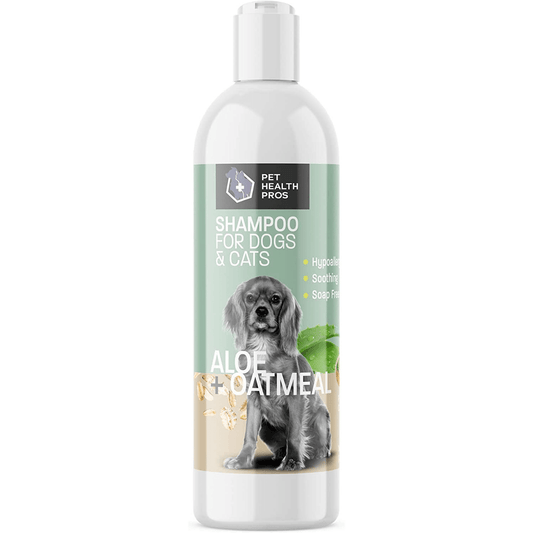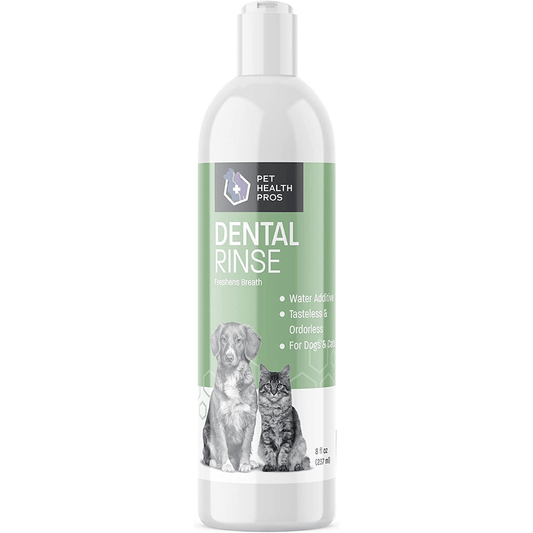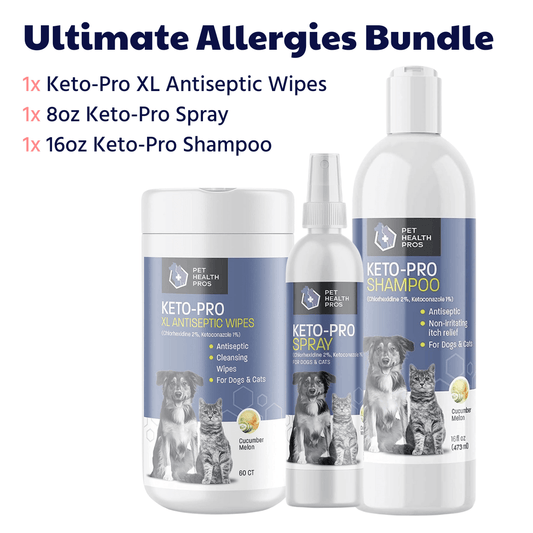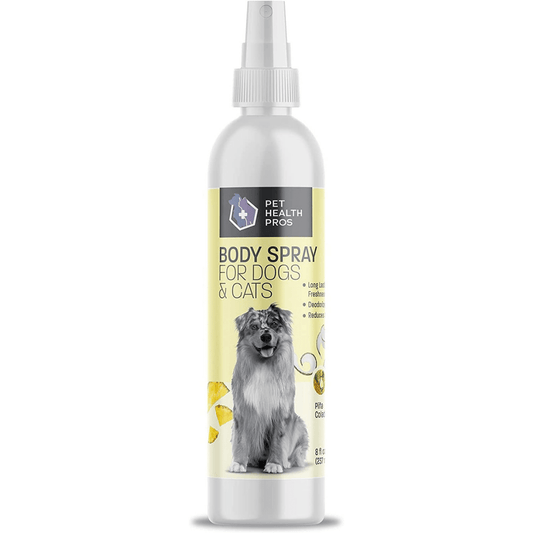Destructive chewing can be a frustrating behavior for dog owners, but understanding the underlying causes and using the right repellents can make a significant difference. Pet Health Pros, a U.S.-based company with over fifty years of experience in veterinary medicine, offers expertly crafted solutions to address this common issue. With products developed in collaboration with veterinarians and made from locally sourced, top-grade ingredients, Pet Health Pros ensures the well-being of your canine companion with a 100% satisfaction guarantee. This article explores how their repellents, combined with proper training techniques, can effectively curb your dog's destructive chewing habits.
Key Takeaways
- Understanding your dog's chewing behavior is crucial for selecting the most effective repellents and training techniques to address destructive habits.
- Choosing the right repellents involves considering natural versus chemical options, their safety and effectiveness, and whether they're veterinarian-approved.
- Effective repellent application requires strategic placement, consistent use, and careful observation of your dog's response to ensure success.
- Repellents are most effective when complemented with positive reinforcement, proper boundaries, and sufficient exercise and mental stimulation for your dog.
- Long-term success in preventing destructive chewing hinges on regular behavior evaluation, adapting strategies as your dog develops, and the ongoing commitment of Pet Health Pros to your dog's health.
Understanding Your Dog's Chewing Behavior
The Psychology Behind Chewing
Dogs have a natural instinct to chew, which stems from their ancestral need to keep their jaws strong and their teeth clean. Chewing is also a form of exploration for dogs, allowing them to experience their world through taste and texture. It's important for pet owners to understand that chewing is a normal behavior for dogs, especially puppies who are teething.
Stress, boredom, and separation anxiety can also lead to increased chewing as a coping mechanism. Identifying the underlying cause of your dog's chewing is crucial in addressing the behavior effectively. Here are some common reasons dogs chew:
- Teething discomfort in puppies
- Boredom or lack of mental stimulation
- Anxiety or stress
- Habit or lack of training
By recognizing the psychological triggers of your dog's chewing, you can tailor your approach to managing it, ensuring a happier and healthier pet.
Identifying Stress-Related Chewing
Dogs may chew as a natural behavior, but when it becomes excessive, it can be a sign of stress or anxiety. Identifying stress-related chewing is crucial in addressing your dog's destructive habits effectively. Look for patterns in your dog's behavior that may indicate stress, such as chewing when left alone or during thunderstorms.
Symptoms of stress-related chewing can vary, but common signs include chewing on inappropriate objects, increased salivation, or a sudden change in chewing habits. Here's a list of potential stressors that could trigger this behavior in dogs:
- Separation anxiety
- Changes in the environment
- Loud noises (e.g., fireworks, thunder)
- New people or pets in the home
- Boredom or lack of stimulation
By understanding the underlying causes of your dog's chewing, you can tailor your approach to managing it, ensuring a happier and healthier pet.
It's important to consult with a veterinarian if you suspect your dog's chewing is stress-related. They can help you develop a plan to reduce anxiety and prevent destructive chewing.
When Chewing Becomes Destructive
Chewing is a natural behavior for dogs, but it can escalate into a destructive habit if not properly managed. Destructive chewing often results from a lack of mental and physical stimulation, leading dogs to seek out inappropriate items to chew on. This can result in damage to household items and potentially harm the dog if they chew on dangerous objects.
Stress and anxiety are also common triggers for destructive chewing. Dogs may turn to chew as a coping mechanism to deal with their emotions. It's crucial to identify the underlying causes of your dog's chewing behavior to address it effectively.
To prevent destructive chewing, consider the following strategies:
- Provide plenty of appropriate chew toys and rotate them to keep your dog's interest.
- Ensure your dog gets adequate exercise and mental stimulation.
- Use repellents on items you don't want your dog to chew, but always prioritize safety.
Consistent use of repellents, combined with positive reinforcement when your dog chews on appropriate items, can significantly reduce unwanted behavior.
Remember, addressing destructive chewing is not just about protecting your belongings; it's about ensuring the safety and well-being of your beloved pet.
Choosing the Right Repellents for Your Dog
Natural vs. Chemical Repellents
When choosing a repellent to curb your dog's destructive chewing, it's essential to weigh the pros and cons of natural versus chemical options. Natural repellents are often made from plant-based ingredients and are favored for their safety and minimal side effects. On the other hand, chemical repellents may offer a stronger deterrent but can carry risks of toxicity if not used correctly.
Ingredients play a crucial role in the effectiveness and safety of repellents. Natural repellents might include citrus oils or spicy capsaicin, which are generally safe for dogs in small quantities. Chemical repellents, however, often contain bitterants like denatonium benzoate, which is extremely bitter and discourages chewing.
It's important to select a repellent that aligns with your comfort level regarding your dog's exposure to chemicals and your personal preference for natural products.
Here's a quick comparison to help you decide:
- Natural Repellents: Eco-friendly, usually milder, safe for most pets and environments.
- Chemical Repellents: Potentially more effective, but requires careful handling and monitoring.
Always consult with a veterinarian, especially when considering products from companies like Pet Health Pros, which are crafted in collaboration with veterinary experts to ensure the well-being of your pet.
Safety and Effectiveness of Ingredients
When selecting a repellent to curb your dog's destructive chewing, the safety and effectiveness of the ingredients are paramount. Natural repellents often use ingredients like vinegar, which can be a safe and low-cost option for pet owners. However, it's crucial to understand that not all natural ingredients are harmless to pets, and some may even cause adverse reactions.
To ensure the safety of your dog, always opt for repellents that are free from harsh chemicals and toxins. Products crafted by veterinarians, such as those offered by Pet Health Pros, are typically made with top-grade, locally sourced ingredients and are backed by a satisfaction guarantee. This commitment to quality can provide reassurance to pet owners about the safety profile of the repellents they use.
The effectiveness of a repellent is not solely determined by its ingredients but also by how it is used. Strategic application and consistent use are key to deterring unwanted chewing behavior.
Lastly, it's advisable to monitor your dog's response to any new repellent. If you notice any signs of discomfort or allergic reactions, discontinue use immediately and consult your veterinarian. By choosing the right product and applying it correctly, you can protect your belongings while keeping your furry friend safe and healthy.
Repellents Crafted by Veterinarians
When selecting repellents to curb your dog's destructive chewing, products crafted by veterinarians offer a unique advantage. These repellents are formulated with a deep understanding of animal behavior and health, ensuring they are both safe and effective. Pet Health Pros, a U.S.-based company, exemplifies this approach with their expertise-driven formulations.
Veterinarian-crafted repellents often incorporate natural ingredients that are non-toxic and safe for your pet. For instance, Pet Health Pros uses locally sourced, top-grade ingredients to create repellents that are gentle yet effective. Their commitment to quality is backed by a 100% satisfaction guarantee, reflecting their dedication to your pet's well-being.
It's essential to administer these deterrents properly. Prepare deterrents with repellent sprays, natural remedies, and motion-activated devices. Administer safely to your dog's food. Monitor effectiveness for desired behavior change.
With over fifty years of combined experience in Veterinary Medicine and Animal Health Management, Pet Health Pros and similar companies offer a range of products that cater to the evolving needs of pets and their owners. By choosing repellents crafted by veterinarians, you're investing in a solution that's designed with your dog's health and happiness in mind.
Applying Repellents Effectively
Strategic Placement for Maximum Impact
The effectiveness of repellents is not just about the product itself, but also where and how it is applied. Strategic placement is crucial for deterring your dog from unwanted chewing. For instance, applying repellents near the items your dog is inclined to chew on can create an immediate association of discomfort, discouraging the behavior.
To maximize the impact, consider the following points:
- Identify the 'hot spots' where your dog frequently chews.
- Apply repellents to these areas, ensuring they are within your dog's reach.
- Reapply as necessary, especially in areas of high dog traffic or where chewing is persistent.
Consistent application in the right places reinforces the message that certain areas are off-limits, aiding in quicker behavior modification.
Remember, while repellents can be a helpful tool, they should be part of a broader approach that includes training and environmental management. Using natural ingredients like citrus or cayenne pepper can be a safe and effective way to keep your dog away from certain areas without causing harm.
Frequency and Consistency of Use
The key to success with repellents is in their consistent application. For a repellent to be effective, it must be used regularly, following the manufacturer's instructions. Inconsistency can lead to confusion for your dog and reduce the effectiveness of the product.
Frequency of application is equally important. Some repellents may require daily use, while others might have a longer-lasting effect. Here's a simple guideline to help you establish a routine:
- Daily: Apply or reapply repellents that are designed to evaporate or wear off quickly.
- Weekly: Check and refresh any physical barriers or slow-release devices.
- As needed: Reapply after cleaning the area or if you notice your dog showing renewed interest in the object.
Consistency in the use of repellents not only helps in deterring destructive chewing but also aids in reinforcing the boundaries you're setting for your pet.
Remember to monitor your dog's response to the repellents. If you notice any signs of irritation or discomfort, discontinue use immediately and consult your veterinarian. Adjusting the frequency of use may be necessary as your dog becomes accustomed to the repellents or as their behavior changes over time.
Monitoring Your Dog's Response to Repellents
After introducing a repellent to deter your dog's destructive chewing, it's crucial to monitor their reaction. Observe whether the repellent effectively discourages the unwanted behavior without causing undue stress or confusion. Some dogs may react differently to various repellents, and it's important to find a balance that works for your pet.
Consistency is key when using repellents. Maintain a regular schedule and document your dog's behavior to track progress. This can be done through a simple log or notes. Here's an example of how you might structure your observations:
- Date and time of repellent application
- Type of repellent used
- Dog's immediate reaction
- Long-term behavior changes
- Any side effects or unusual behavior
By keeping a detailed record, you can identify patterns and adjust the repellent type or application frequency as needed. This proactive approach ensures the well-being of your dog while addressing the chewing issue.
Remember to consider the guide on addressing dog chewing behavior: use no chew spray, provide alternatives, positive reinforcement, and address underlying causes. Combining spray with behavioral solutions for lasting results is essential.
Complementing Repellents with Training Techniques
Positive Reinforcement and Behavior Modification
In the realm of dog training, positive reinforcement is a cornerstone technique that encourages good behavior by rewarding dogs for their desirable actions. Rewarding your dog for not chewing on inappropriate items can be more effective than punishment for unwanted behavior. This approach not only strengthens the bond between you and your pet but also promotes a positive learning environment.
- Identify the behavior you wish to reinforce.
- Choose a reward that is highly motivating for your dog.
- Deliver the reward immediately after the desired behavior.
- Be consistent with your reinforcement to establish a clear pattern.
Consistency is key in behavior modification. By regularly rewarding your dog for positive behavior, you create a predictable pattern that your dog can easily follow.
By integrating positive reinforcement into your dog's routine, you can gradually replace destructive chewing habits with more acceptable behaviors. It's important to monitor your dog's progress and adjust your approach as needed to ensure the best outcomes.
Setting Boundaries and Creating a Chew-Friendly Environment
Establishing clear boundaries is crucial for dogs to understand what is acceptable behavior within their home environment. Creating a designated chew-friendly area can significantly reduce the likelihood of destructive chewing elsewhere. This space should be stocked with a variety of safe, durable chew toys that cater to your dog's size and chewing style.
To reinforce these boundaries, consistency is key. Always redirect your dog to their chew-friendly zone when they pick up an inappropriate item. Over time, your dog will associate this area with positive chewing experiences. Here's a simple guide to setting up a chew-friendly space:
- Choose a specific area that's easily accessible to your dog.
- Equip the area with a range of chew toys and rotate them regularly to maintain interest.
- Ensure the space is free from any items you don't want your dog to chew.
By patiently guiding your dog and providing ample opportunities for appropriate chewing, you can foster a harmonious living space for both you and your pet.
The Role of Exercise and Mental Stimulation
Exercise and mental stimulation play a crucial role in preventing destructive chewing behaviors in dogs. Regular physical activity is essential for keeping your dog healthy and satisfied, which can reduce the likelihood of them seeking out inappropriate items to chew. A well-exercised dog is typically more relaxed and less driven to engage in destructive behavior.
In addition to physical exercise, mental stimulation is equally important. Providing your dog with puzzle toys, training sessions, and new experiences can keep their mind engaged and focused. This mental enrichment helps prevent boredom, which is often a trigger for destructive chewing.
By integrating both physical and mental activities into your dog's daily routine, you create a balanced approach to managing their chewing habits. This not only helps in reducing unwanted behavior but also contributes to their overall well-being.
It's important to assess your pet's individual needs and preferences when choosing activities. Some dogs may require more vigorous exercise, while others benefit from more cognitive challenges. Tailoring the activities to your dog ensures they receive the most benefit and enjoyment.
Ensuring Long-Term Success
Regularly Evaluating Your Dog's Behavior
To ensure the long-term success of using repellents to curb destructive chewing, it is crucial to regularly assess your dog's behavior. This ongoing evaluation helps in understanding whether the current strategies are effective or if they need adjustments. Start by observing your dog's interaction with the areas and objects you've treated with repellents.
Consistency is key when it comes to behavior modification. Keep a log of your dog's chewing incidents, noting any patterns or changes over time. This can be as simple as marking a calendar or keeping notes in a journal. Here's an example of how to structure your observations:
- Date and time of chewing incident
- Location of the incident
- Object chewed on
- Possible trigger or preceding event
- Repellent used and its apparent effectiveness
By maintaining a detailed record, you can identify trends and determine the efficacy of the repellents. This proactive approach allows for timely interventions and helps in tailoring a more personalized plan for your dog.
Remember to consider the context of your dog's behavior. Changes in the household, routine, or even the introduction of new pets can influence chewing habits. Adjust your strategies accordingly to maintain a harmonious environment for your dog.
Adjusting Strategies as Your Dog Grows
As your dog matures, its needs and behaviors will evolve, necessitating adjustments to your repellent strategies. Puppies may require more frequent applications of repellents as they are in the peak of their teething phase, while adult dogs might benefit from a more targeted approach as their chewing habits become more predictable.
Consistency is key when adapting repellent use over time. It's important to observe your dog and adjust the type and amount of repellent based on their current chewing patterns and preferences. Here's a simple guide to follow:
- Monitor your dog's chewing habits regularly.
- Adjust the strength and application frequency of repellents as needed.
- Introduce new repellents if old ones become less effective.
As dogs age, their tolerance for certain ingredients may change, and what was once effective may no longer deter them from chewing. It's crucial to stay attuned to these shifts and modify your approach accordingly.
Remember, the goal is to ensure the safety and happiness of your growing dog while protecting your belongings. By staying vigilant and responsive to your dog's changing needs, you can maintain a harmonious home environment.
Pet Health Pros' Commitment to Your Dog's Well-being
At the heart of Pet Health Pros is a deep-seated dedication to the health and happiness of your canine companions. With over fifty years of combined experience in veterinary medicine and animal health management, Pet Health Pros is not just a brand; it's a community of experts committed to providing superior, affordable pet health supplies.
Backed by a 100% satisfaction guarantee, their products are a testament to their brand promise to enhance the lives of pets. Each item is crafted in collaboration with veterinarians, ensuring that your dog benefits from expertise-driven formulations and quality ingredients.
Pet Health Pros stands out with its commitment to customer satisfaction, offering a 100% satisfaction guarantee and a brand promise to enhance the lives of pets.
The company's approach to customer service is as caring and innovative as the products they offer. Whether through their online store, personalized customer service, or educational content, Pet Health Pros ensures that every interaction is an opportunity to support and educate pet owners on the best practices for their dog's well-being.
At Pet Health Pros, we're committed to providing top-quality pet health supplies that ensure the well-being of your furry friends. Our products are vet-recommended and made with the highest quality ingredients sourced right here in the USA. To ensure your pet's long-term success and happiness, visit our website and explore our wide range of wellness, grooming, and dental care products. Your satisfaction is our priority, and we back our products with a 100% satisfaction guarantee. Don't wait, take the first step towards a healthier pet today!
Conclusion
In conclusion, managing your dog's destructive chewing behavior is essential for maintaining a harmonious home and ensuring the safety of your beloved pet. By utilizing effective repellents, you can deter unwanted chewing and protect your possessions. Remember to choose products that are safe for your dog and align with your values as a pet owner. Pet Health Pros offers a range of superior, affordable pet health supplies, including repellents crafted in collaboration with veterinarians and made with locally sourced, top-grade ingredients. With over fifty years of experience in veterinary medicine and a commitment to the well-being of pets, you can trust Pet Health Pros to provide solutions that cater to the evolving needs of your pet. Whether you shop through our online store or our Amazon storefront, you can be confident in our brand promise to enhance the lives of pets and reassure their owners with expertly crafted solutions. For healthier pets and happier lives, trust Pet Health Pros to be your partner in pet care.
Frequently Asked Questions
Why does my dog chew destructively?
Destructive chewing can be a sign of various issues such as boredom, separation anxiety, teething in puppies, or lack of proper chew toys. Understanding the underlying cause is crucial to addressing the behavior.
Are natural repellents effective for stopping my dog's chewing?
Natural repellents can be effective and are often preferred due to their safety. Ingredients like bitter apple, citrus, and menthol are commonly used. However, effectiveness varies with each dog's taste and smell preferences.
How often should I apply repellents to deter my dog from chewing?
The frequency of repellent application can depend on the product's formulation. It's important to follow the manufacturer's instructions, usually found on the packaging, for the best results.
Can training complement the use of repellents in stopping destructive chewing?
Absolutely. Training is an essential component in managing destructive chewing. Positive reinforcement, setting boundaries, and providing appropriate chew toys can significantly enhance the effectiveness of repellents.
How do I know if a repellent is safe for my dog?
Always choose repellents that are specifically designed for dogs and check for ingredients that are non-toxic and safe for pets. Products crafted by veterinarians, like those from Pet Health Pros, are a reliable choice.
What should I do if my dog continues to chew despite using repellents?
If your dog persists in destructive chewing, it may be necessary to reassess the situation. Consider consulting a professional trainer or veterinarian, and ensure your dog has plenty of appropriate chew toys and sufficient exercise.









